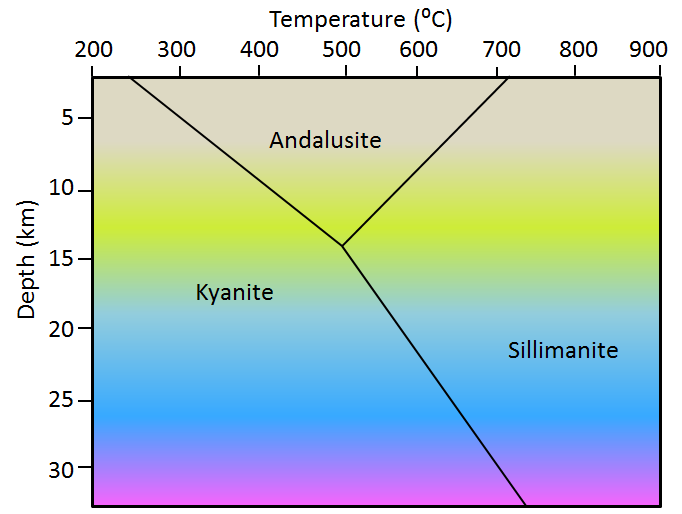57 7.1 Controls Over Metamorphic Processes — Physical Geology – 2nd Edition

Pressure
Pressure is important in metamorphic processes for two main reasons. First, it has implications for mineral stability (Figure 7.1.1). Second, it has implications for the texture of metamorphic rocks. Rocks that are subjected to very high confining pressures are typically denser than others because the mineral grains are squeezed together (Figure 7.1.2a), and also because they may contain minerals that have greater density because the atoms are more closely packed.
Because of plate tectonics, pressures within the crust are typically not applied equally in all directions. In areas of plate convergence, for example, the pressure in one direction (perpendicular to the direction of convergence) is typically greater than in the other directions (Figure 7.1.2b). In situations where different blocks of the crust are being pushed in different directions, the rocks will likely be subjected to sheer stress (Figure 7.1.2c).
One of the results of directed pressure and shear stress is that rocks become foliated—meaning that they’ll have a directional fabric. Foliation a very important aspect of metamorphic rocks, and is described in more detail later in this chapter.

Fluids
Water is the main fluid present within rocks of the crust, and the only one that we’ll consider here. The presence of water is important for two main reasons. First, water facilitates the transfer of ions between minerals and within minerals, and therefore increases the rates at which metamorphic reactions take place. So, while the water doesn’t necessarily change the outcome of a metamorphic process, it speeds the process up so metamorphism might take place over a shorter time period, or metamorphic processes that might not otherwise have had time to be completed are completed.
Secondly, water, especially hot water, can have elevated concentrations of dissolved elements (ions), and therefore it is an important medium for moving certain elements around within the crust. So not only does water facilitate metamorphic reactions on a grain-to-grain basis, it also allows for the transportation of elements from one place to another. This is very important in hydrothermal processes, which are discussed toward the end of this chapter, and in the formation of mineral deposits.
Time
Most metamorphic reactions take place at very slow rates. For example, the growth of new minerals within a rock during metamorphism has been estimated to be about 1 millimetre per million years. For this reason, it is very difficult to study metamorphic processes in a lab.
While the rate of metamorphism is slow, the tectonic processes that lead to metamorphism are also very slow, so in most cases, the chance for metamorphic reactions to be completed is high. For example, one important metamorphic setting is many kilometres deep within the roots of mountain ranges. A mountain range takes tens of millions of years to form, and tens of millions of years more to be eroded to the extent that we can see the rocks that were metamorphosed deep beneath it.
This photo shows a sample of garnet-mica schist from the Greek island of Syros. The large reddish crystals are garnet, and the surrounding light coloured rock is dominated by muscovite mica. The Euro coin is 23 millimetres in diameter. Assume that the diameters of the garnets increased at a rate of 1 millimetre per million years.
Based on the approximate average diameter of the garnets visible, estimate how long this metamorphic process might have taken.
See Appendix 3 for Exercise 7.1 answers.
Image Descriptions
| Depth (kilometres) | Kyanite | Andalusite | Sillimanite |
|---|---|---|---|
| 5 | Less than 300°C | 300 to 650°C | Greater than 670°C |
| 10 | Less than 400°C | 410 to 580°C | Greater than 590°C |
| 15 | Less than 500°C | Not stable | Greater than 500°C |
| 20 | Less than 570°C | Not stable | Greater than 590°C |
| 25 | Less than 640°C | Not stable | Greater than 620°C |
| 30 | Less than 700°C | Not stable | Greater than 700°C |
Media Attributions
- Figures 7.1.1, 7.1.2: © Steven Earle. CC BY.
- Figure 7.1.3: Garnet Mica Schist Syros Greece © Graeme Churchard. CC BY.
<!– pb_fixme –>
<!– pb_fixme –>

